当前位置:
X-MOL 学术
›
Hell. J. Cardiol.
›
论文详情
Our official English website, www.x-mol.net, welcomes your feedback! (Note: you will need to create a separate account there.)
Ergophysiological evaluation of heart failure patients with reduced ejection fraction undergoing exercise-based cardiac rehabilitation: A systematic review and meta-analysis
Hellenic Journal of Cardiology ( IF 4.1 ) Pub Date : 2024-01-19 , DOI: 10.1016/j.hjc.2024.01.004 Georgios A. Christou , Maria A. Christou , Constantinos H. Davos , Georgios Markozannes , Konstantinos A. Christou , Stefanos Mantzoukas , Dimitrios K. Christodoulou , Dimitrios N. Kiortsis , Panagiota A. Christou , Stelios Tigas , Dimitra Nikoletou
Hellenic Journal of Cardiology ( IF 4.1 ) Pub Date : 2024-01-19 , DOI: 10.1016/j.hjc.2024.01.004 Georgios A. Christou , Maria A. Christou , Constantinos H. Davos , Georgios Markozannes , Konstantinos A. Christou , Stefanos Mantzoukas , Dimitrios K. Christodoulou , Dimitrios N. Kiortsis , Panagiota A. Christou , Stelios Tigas , Dimitra Nikoletou

|
This systematic review and meta-analysis aims to explore in heart failure (HF) patients with reduced ejection fraction (EF) undergoing exercise-based cardiac rehabilitation the following: 1) the comparison of temporal changes between peak oxygen uptake (VO2peak) and first ventilatory threshold (VO2VT1), 2) the association of VO2peak and VO2VT1 changes with physiological factors, and 3) the differential effects of continuous aerobic exercise (CAE) and interval training (IT) on VO2peak and VO2VT1. A systematic literature search was conducted in PubMed, CENTRAL, and Scopus. Inclusion criteria were 1) original research articles using exercise-based cardiac rehabilitation, 2) stable HF patients with reduced EF, 3) available values of VO2peak and VO2VT1 (in mL/kg/min) both at baseline and after exercise training with comparison between these time points. Among the 30 eligible trials, 24 used CAE, 5 IT, and one CAE and IT. Multivariable meta-regression with duration of exercise training and percentage of males as independent variables and the change in VO2peak as a dependent variable showed that the change in VO2peak was negatively associated with duration of exercise training (coefficient=-0.061, p=0.027), implying the possible existence of a waning effect of exercise training on VO2peak in the long term. Multivariable meta-regression demonstrated that both age (coefficient=-0.140, p<0.001) and EF (coefficient=-0.149, p<0.001) could predict the change in VO2VT1, whereas only age (coefficient=-0.095, p=0.022), but not EF (coefficient = 0.082, p = 0.100), could predict the change in VO2peak. The posttraining peak respiratory exchange ratio, as an index of maximum effort during exercise testing, correlated positively with the change in VO2peak (coefficient=-0.021, p=0.044). The exercise-induced changes of VO2peak (p = 0.438) and VO2VT1 (p = 0.474) did not differ between CAE and IT groups. Improvement of endurance capacity during cardiac rehabilitation may be detected more accurately with the assessment of VO2VT1 rather than VO2peak.
中文翻译:

射血分数降低的心力衰竭患者接受基于运动的心脏康复的人体工学评估:系统评价和荟萃分析
本系统综述和荟萃分析旨在探讨射血分数 (EF) 降低的心力衰竭 (HF) 患者接受基于运动的心脏康复的以下内容:1) 峰值摄氧量 (VO2peak) 与首次通气之间的时间变化比较阈值(VO2VT1),2)VO2peak和VO2VT1变化与生理因素的关联,以及3)连续有氧运动(CAE)和间歇训练(IT)对VO2peak和VO2VT1的不同影响。在 PubMed、CENTRAL 和 Scopus 中进行了系统的文献检索。纳入标准为 1) 使用基于运动的心脏康复的原始研究文章,2) 射血分数降低的稳定心力衰竭患者,3) 基线时和运动训练后的 VO2peak 和 VO2VT1 的可用值(以 mL/kg/min 为单位),并比较这些时间点。在 30 项符合条件的试验中,24 项使用了 CAE,5 项使用了 IT,1 项使用了 CAE 和 IT。以运动训练持续时间和男性百分比为自变量、VO2peak 变化作为因变量的多变量元回归表明,VO2peak 变化与运动训练持续时间呈负相关(系数=-0.061,p=0.027),这意味着从长远来看,运动训练对 VO2peak 的影响可能会减弱。多变量元回归表明,年龄(系数=-0.140,p<0.001)和EF(系数=-0.149,p<0.001)都可以预测VO2VT1的变化,而只有年龄(系数=-0.095,p=0.022) ,但 EF(系数 = 0.082,p = 0.100)可以预测 VO2peak 的变化。训练后峰值呼吸交换比作为运动测试期间最大努力程度的指标,与 VO2peak 的变化呈正相关(系数=-0.021,p=0.044)。运动引起的 VO2peak (p = 0.438) 和 VO2VT1 (p = 0.474) 变化在 CAE 组和 IT 组之间没有差异。通过评估 VO2VT1 而不是 VO2peak,可以更准确地检测心脏康复过程中耐力能力的提高。
更新日期:2024-01-19
中文翻译:

射血分数降低的心力衰竭患者接受基于运动的心脏康复的人体工学评估:系统评价和荟萃分析
本系统综述和荟萃分析旨在探讨射血分数 (EF) 降低的心力衰竭 (HF) 患者接受基于运动的心脏康复的以下内容:1) 峰值摄氧量 (VO2peak) 与首次通气之间的时间变化比较阈值(VO2VT1),2)VO2peak和VO2VT1变化与生理因素的关联,以及3)连续有氧运动(CAE)和间歇训练(IT)对VO2peak和VO2VT1的不同影响。在 PubMed、CENTRAL 和 Scopus 中进行了系统的文献检索。纳入标准为 1) 使用基于运动的心脏康复的原始研究文章,2) 射血分数降低的稳定心力衰竭患者,3) 基线时和运动训练后的 VO2peak 和 VO2VT1 的可用值(以 mL/kg/min 为单位),并比较这些时间点。在 30 项符合条件的试验中,24 项使用了 CAE,5 项使用了 IT,1 项使用了 CAE 和 IT。以运动训练持续时间和男性百分比为自变量、VO2peak 变化作为因变量的多变量元回归表明,VO2peak 变化与运动训练持续时间呈负相关(系数=-0.061,p=0.027),这意味着从长远来看,运动训练对 VO2peak 的影响可能会减弱。多变量元回归表明,年龄(系数=-0.140,p<0.001)和EF(系数=-0.149,p<0.001)都可以预测VO2VT1的变化,而只有年龄(系数=-0.095,p=0.022) ,但 EF(系数 = 0.082,p = 0.100)可以预测 VO2peak 的变化。训练后峰值呼吸交换比作为运动测试期间最大努力程度的指标,与 VO2peak 的变化呈正相关(系数=-0.021,p=0.044)。运动引起的 VO2peak (p = 0.438) 和 VO2VT1 (p = 0.474) 变化在 CAE 组和 IT 组之间没有差异。通过评估 VO2VT1 而不是 VO2peak,可以更准确地检测心脏康复过程中耐力能力的提高。



























 京公网安备 11010802027423号
京公网安备 11010802027423号